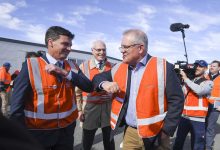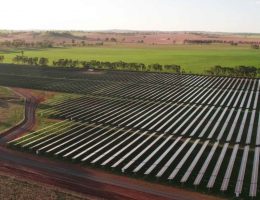Angus Taylor’s problems with numbers continue. Modelling included in the Liddell Task Force report reveals that the federal energy minister and prime minister Scott Morrison exaggerated the price impacts used to justify their extraordinary threat to intervene in the electricity market and build a massive new gas plant.
The Coalition government claimed that prices would “skyrocket” if the Liddell capacity to be retired in early 2023 was not replaced by the private sector. But the Liddell Task Force Report – which has been sitting on Taylor’s desk for five months – has finally been published and does not back this claim.
And while the full modelling conducted by Frontier Economics has been withheld by the government, enough detail is revealed in the part that is published to shows that Taylor and Morrison have been gilding the lily when they argued the case for a new 1GW gas plant.
The energy industry has been stunned by the federal Coalition’s threat of intervention, where Morrison and Taylor promised to get the government owned utility snowy Hydro to build a 1GW gas generator if the market failed to commit to building enough dispatchable capacity to replace Liddell by next April.
Even the peak lobby group for the generators, the Australian Energy Council, said the heavy handed intervention was likely to deter investment because few would want to commit to a new asset with the threat of a government subsidised competitor hanging over their heads.
Morrison drew comparisons with the sudden closure of Hazelwood, but the Liddell task force said the reliability and grid security issues in NSW was not as intense, and nor were the cost impacts, given that most coal generators in NSW already operate well below capacity and “there is likely to be relatively more surplus capacity available in the market than was the case for Hazelwood.”
The report contradicts the claim by Taylor and Morrison that another 1,000MW of dispatchable power was needed to replace Liddell on the basis of reliability, and their attempts to justify this on price.
They argued that if Liddell was not properly replaced by private investment then the average cost of electricity in NSW could jump by around $20/MWh. “The problem here is price,” Taylor said.
As we reported on Tuesday, the media backgrounder provided by the government sought to deliberately exaggerate this impact by their use of this graph below, cut off at $50/MWh rather than zero. “We risk prices skyrocketing following the closure of Liddell”, it says.
But that’s not what the modelling says. For a start, it suggests the average price in NSW in 2022 will be the low in the $60s/MWh, not the mid $50s/MWh represented in the government’s graph.
“The modelling suggests Liddell’s planned closure could lead to a NSW wholesale price increase from the low $60s per MWh in 2022 to between $75 and $80 per MWh in 2023–24, depending on the market response to deliver new capacity,” the task force report says.
“The modelling further suggests some price rise irrespective of a Liddell extension.”
In detail, if two units at Liddell were extended, then the price would rise to around $70/MWh in 2024 – although this was not recommended because extending the ageing units posed safety and reliability risks, and would impact on other investments elsewhere in the grid.
If Liddell’s capacity was replaced by the private sector, then prices were still likely to rise to around $75/MWh, and average more than $71/MWh for the next few years.
If Liddell was not replaced, and Snowy 2.0 and planned transmission upgrades were delayed, then the NSW average wholesale prices could rise to around $80/MWh in 2023–24 as Liddell exits. In this ’no replacement’ scenario, annual average NSW wholesale prices remain close to or above $80/MWh for the remainder of the decade as other plants close.
In other words, even adding in any delays to Snowy and transmission upgrades, the difference between Liddell replaced by the market, and Liddell not replaced by the market is actually not huge – and definitely not “skyrocketing” as pretended by the PM and his minister.
The most important thing for consumers, however, is that the market doesn’t agree.
The problem is that this modelling for the task force was completed months ago, and was not asked to model what would happen if more investment was made than strictly needed for energy security needs.
And it also did not include the recently announced capacity additions, including the four big batteries funded by the NSW government, and AGL’s own plans to have more than 1.2GW of battery storage, including a big battery of up to 500MW at Liddell, the new renewable energy zones announced by the NSW government, or the 1.4MW of capacity to be auctioned by Transgrid for a new line to be built by 20202.
The market has seen those announcements, and so it is pricing NSW wholesale prices at a much lower level than the task force report – it has the wholesale price in NSW in the mid $50s in 2022, rising slowly to the high $50s in 2024. No skyrocketing there.
 That’s because the market likely judges that as the price of wind and solar and battery storage comes down, then more capacity will be built than needed for strictly energy security purposes, creating more competition in the market.
That’s because the market likely judges that as the price of wind and solar and battery storage comes down, then more capacity will be built than needed for strictly energy security purposes, creating more competition in the market.
At least that was the expectation before Morrison and Taylor barged into the room, kicked over tables, tore up market conventions, and more or less declared “don’t be scared”, “this is gas’ and “Snowy is going to build it” if you don’t.
So the chances of that excess private investment being built are now reduced. The price rises modelled by Frontier are likely to be self-fulfilling, and, should it turn out that way, the people directly responsible for this outcome will be Morrison and Taylor and their fossil-fuelled advisory teams.











